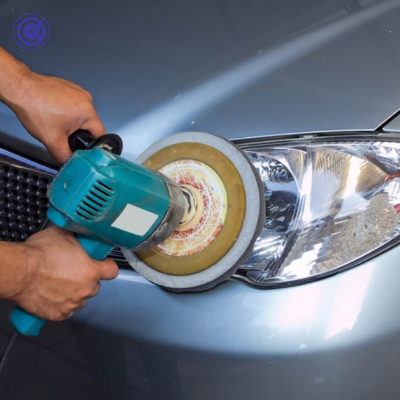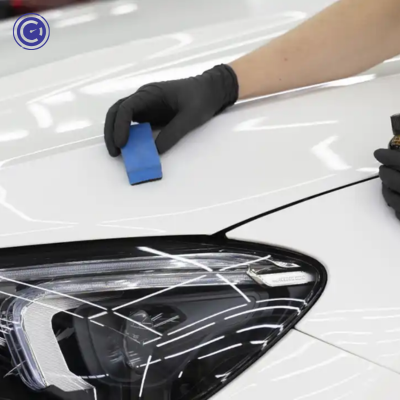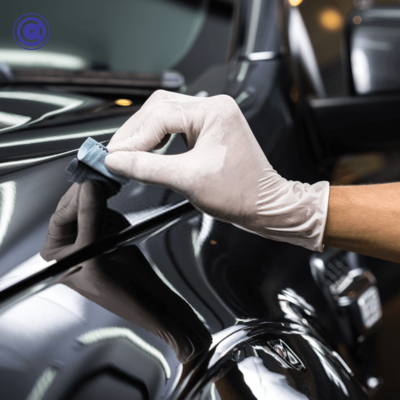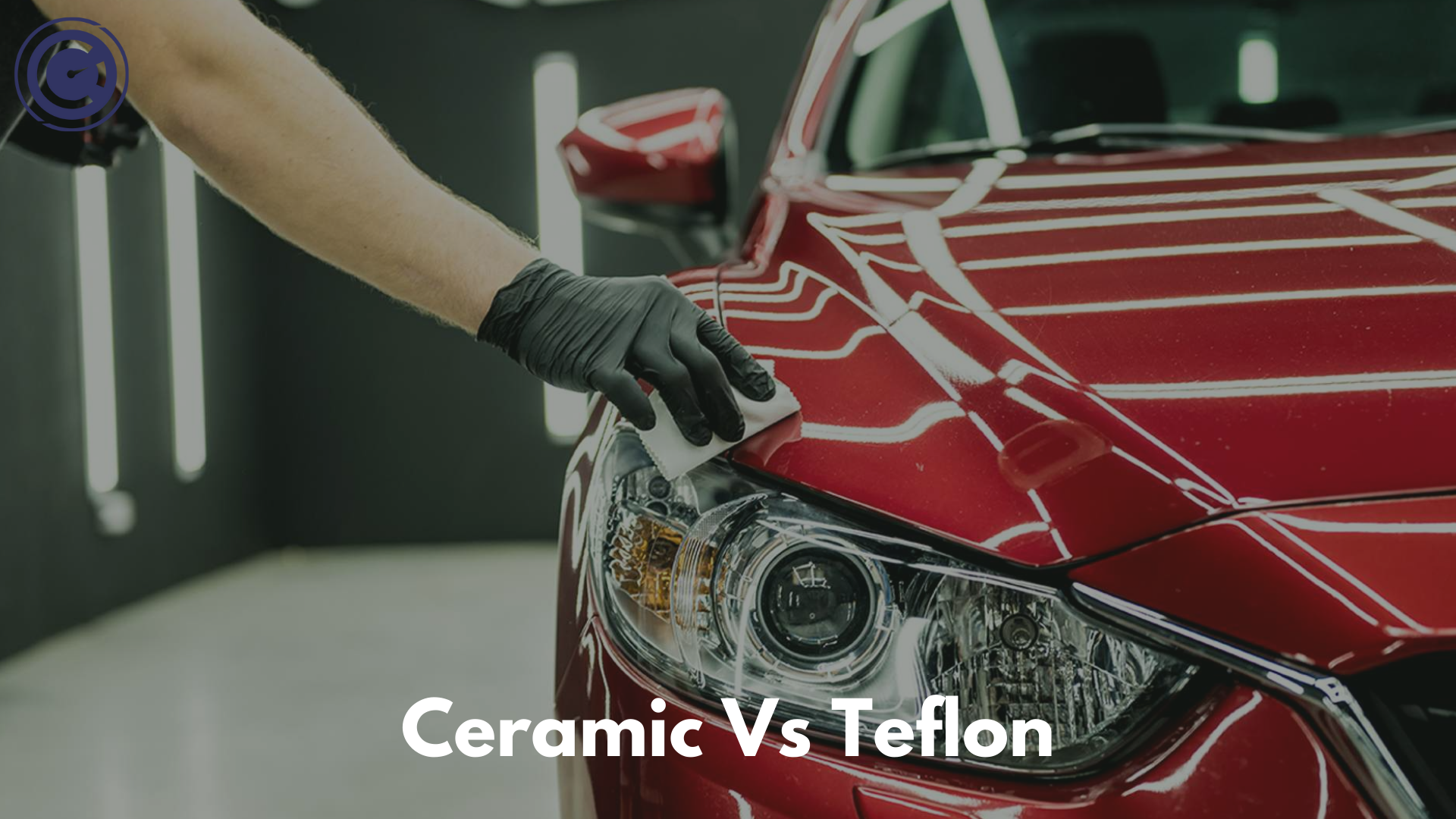Choosing the right coating for your vehicle is crucial for protecting its exterior and maintaining its shine. Teflon and Ceramic coatings are popular choices, each offering unique benefits. This article delves into the differences between these two types of coatings, helping you make an informed decision.
Table of Contents
Teflon Coating vs Ceramic Coating
What is Teflon Coating?

Teflon, a brand name for PTFE, is a non-stick coating used in various industries, including automotive. When applied to cars, it forms a protective layer that repels water and dirt. The application process involves a thorough cleaning followed by the application of the Teflon coat.
Benefits of Teflon Coating
Teflon coating, often applied to cars, offers several benefits that enhance the vehicle’s appearance and protect its exterior. Here’s an overview of the key benefits of Teflon coating:
1. Paint Protection
- Effect: Creates a protective layer over the car’s paint.
- Benefits: Shields the paint from scratches, dirt, and minor abrasions.
2. Enhanced Gloss and Shine
- Effect: Teflon adds a glossy sheen to the car’s exterior.
- Benefits: Improves the vehicle’s aesthetic appeal and maintains a new-like finish.
3. Resistance to Environmental Damages
- Effect: Offers resistance against environmental pollutants like bird droppings, tree sap, and UV rays.
- Benefits: Protects the paint from fading, discoloration, and chemical etching.
4. Ease of Cleaning
- Effect: Teflon’s smooth surface repels water and dust.
- Benefits: Makes cleaning easier and less frequent, as dirt and grime don’t stick easily.
5. Corrosion Resistance
- Effect: Acts as a barrier against rust and corrosion.
- Benefits: Prolongs the lifespan of the car’s paint, especially in coastal areas with salty air.
6. Water and Stain Repellent
- Effect: The hydrophobic nature of Teflon repels water and oil-based stains.
- Benefits: Keeps the car looking cleaner and prevents water spots.
7. Durability
- Effect: Teflon coatings are durable and long-lasting.
- Benefits: Offers extended protection without the need for frequent reapplication.
Limitations of Teflon Coating
While Teflon coating offers several benefits for car protection, it also has certain limitations:
- Not Scratch-Proof: Teflon coatings can reduce the impact of minor scratches but are not entirely scratch-proof against harsh abrasions.
- Regular Reapplication Needed: The coating is not permanent and requires reapplication every few months for continuous protection.
- Limited Protection: It provides minimal protection against major dents or damage from accidents.
- Cost: Professional Teflon coating services can be expensive, depending on the quality and brand of the product.
- False Claims: Some products in the market may overstate the benefits of Teflon coating, leading to unrealistic expectations.
- Environmental Impact: The process of applying Teflon coating involves chemicals, which may have environmental concerns.
- Ineffectiveness on Old Paint: Teflon coatings are less effective on cars with older, already damaged paint jobs.
- Dependency on Quality of Application: The effectiveness of the coating largely depends on the quality of the application process.
Understanding these limitations is crucial when considering Teflon coating for your vehicle, ensuring you have realistic expectations of its protective capabilities.
What is Ceramic Coating?

Ceramic coating is a liquid polymer that chemically bonds with the vehicle’s paint, creating a protective layer. It’s known for its superior durability and high resistance to water, UV rays, and chemicals.
Advantages of Ceramic Coating
Ceramic coating for vehicles is a liquid polymer that chemically bonds with the car’s factory paint, creating a protective layer. Its popularity has surged due to its numerous advantages:
1. Superior Paint Protection
- Effect: Forms a hard, protective layer over paint.
- Benefits: Shields against minor scratches, UV rays, chemical stains, and environmental contaminants.
2. Enhanced Gloss and Aesthetics
- Effect: Adds a deep, rich gloss to the vehicle’s exterior.
- Benefits: Elevates the overall aesthetic appeal, making the car look consistently polished and new.
3. Hydrophobic Nature
- Effect: Repels water and water-based dirt and grime.
- Benefits: Makes cleaning easier and more effective, as water beads up and rolls off the surface.
4. Long-Lasting Protection
- Effect: When applied correctly, lasts longer than traditional waxes.
- Benefits: Provides years of protection, reducing the need for frequent applications.
5. Chemical and Stain Resistance
- Effect: Resistant to acidic contaminants and chemicals.
- Benefits: Protects paint from etching, bird droppings, tree sap, and air pollutants.
6. UV Damage and Oxidation Prevention
- Effect: Prevents oxidation and fading caused by UV exposure.
- Benefits: Keeps the paint looking fresh and prevents sun damage.
7. Thermal Resistance
- Effect: Can withstand high temperatures.
- Benefits: Maintains integrity and protection even in hot climates.
8. Cost-Effective in the Long Run
- Effect: Though initially more expensive, its durability makes it cost-effective.
- Benefits: Reduces the need for frequent washes, waxing, and paint correction over time.
In conclusion, ceramic coating offers a high level of protection and convenience, preserving the vehicle’s appearance and reducing maintenance requirements. It’s an investment in extending the life and beauty of your car’s paint job.
Challenges with Ceramic Coating

Ceramic coating, while beneficial, comes with its own set of challenges:
- Cost: Generally more expensive than traditional waxes or sealants.
- Application Process: Requires professional application for best results; DIY kits are challenging for amateurs.
- Maintenance Required: Although it reduces maintenance frequency, improper care can diminish its effectiveness.
- Not Completely Scratch-Proof: Provides resistance but not immunity to scratches and swirl marks.
- Reapplication: Over time, it will wear off and require reapplication.
- Preparation Work: The vehicle needs thorough cleaning and possibly paint correction before application.
- Misconceptions: Often misunderstood as a one-stop solution for all paint protection needs.
- Environmental Limitations: Performance can vary based on the environmental conditions and exposure.
Understanding these challenges is crucial for setting realistic expectations and ensuring proper care and maintenance of ceramic-coated vehicles.
Teflon vs Ceramic: Durability Comparison
When comparing the durability of Teflon versus Ceramic coatings for vehicles, here are some key points to consider:
Teflon Coating
- Durability: Typically lasts for a few months up to a year, depending on conditions and care.
- Protection Level: Offers good protection against scratches and environmental elements but wears off quicker.
- Reapplication: Needs more frequent reapplication compared to ceramic coatings.
Ceramic Coating
- Durability: Can last for several years, often 2-5 years, providing a more permanent solution.
- Protection Level: Offers a higher level of protection against scratches, UV rays, and harsh chemicals.
- Reapplication: Requires less frequent reapplication due to its long-lasting properties.
General Comparison
- Ceramic is More Durable: Ceramic coatings generally offer a longer-lasting protective layer than Teflon.
- Teflon is Less Resilient: Teflon coatings, while effective, tend to degrade faster and thus need more regular maintenance.
- Environmental Factors: The durability of both coatings can be affected by environmental factors like sun exposure, pollution, and frequency of washing.
In summary, ceramic coatings tend to be more durable and offer superior long-term protection compared to Teflon coatings, though they come with a higher initial cost and application requirements.
Cost Analysis: Teflon Coating vs Ceramic Coating
When considering Teflon versus Ceramic coatings for vehicles, cost is a crucial factor. Here’s an analysis of the costs associated with both:
Teflon Coating
- Initial Cost: Generally more affordable than ceramic coating. The cost varies based on vehicle size and brand but is usually in the lower to mid-range.
- Long-Term Cost: Due to its lesser durability, Teflon coating requires more frequent reapplications, which can increase the overall cost over time.
Ceramic Coating
- Initial Cost: Higher upfront cost compared to Teflon coating. The price depends on factors like the quality of the product and the professional service fee.
- Long-Term Cost: Despite the higher initial expense, the long-lasting nature of ceramic coatings means fewer reapplications, potentially leading to lower costs over the life of the vehicle.
Cost-Benefit Analysis
- Value for Money: While ceramic coatings are more expensive upfront, they may offer better value over time due to their durability and the level of protection they provide.
- Maintenance Savings: Ceramic coatings can reduce the need for regular washes and waxing, saving money on maintenance.
- Vehicle Condition: The condition of the vehicle’s paint can also affect the cost. Vehicles requiring extensive paint correction before coating will incur additional charges.
Aesthetic Differences Between Teflon and Ceramic Coatings
Maintenance and Care for Coated Vehicles
Making the Right Choice: Factors to Consider
Conclusion
Both Teflon and Ceramic coatings offer significant benefits for protecting your vehicle. Your choice depends on your specific needs, budget, and the level of maintenance you’re comfortable with. Regardless of your choice, both coatings provide valuable protection and enhance your vehicle’s appearance.

